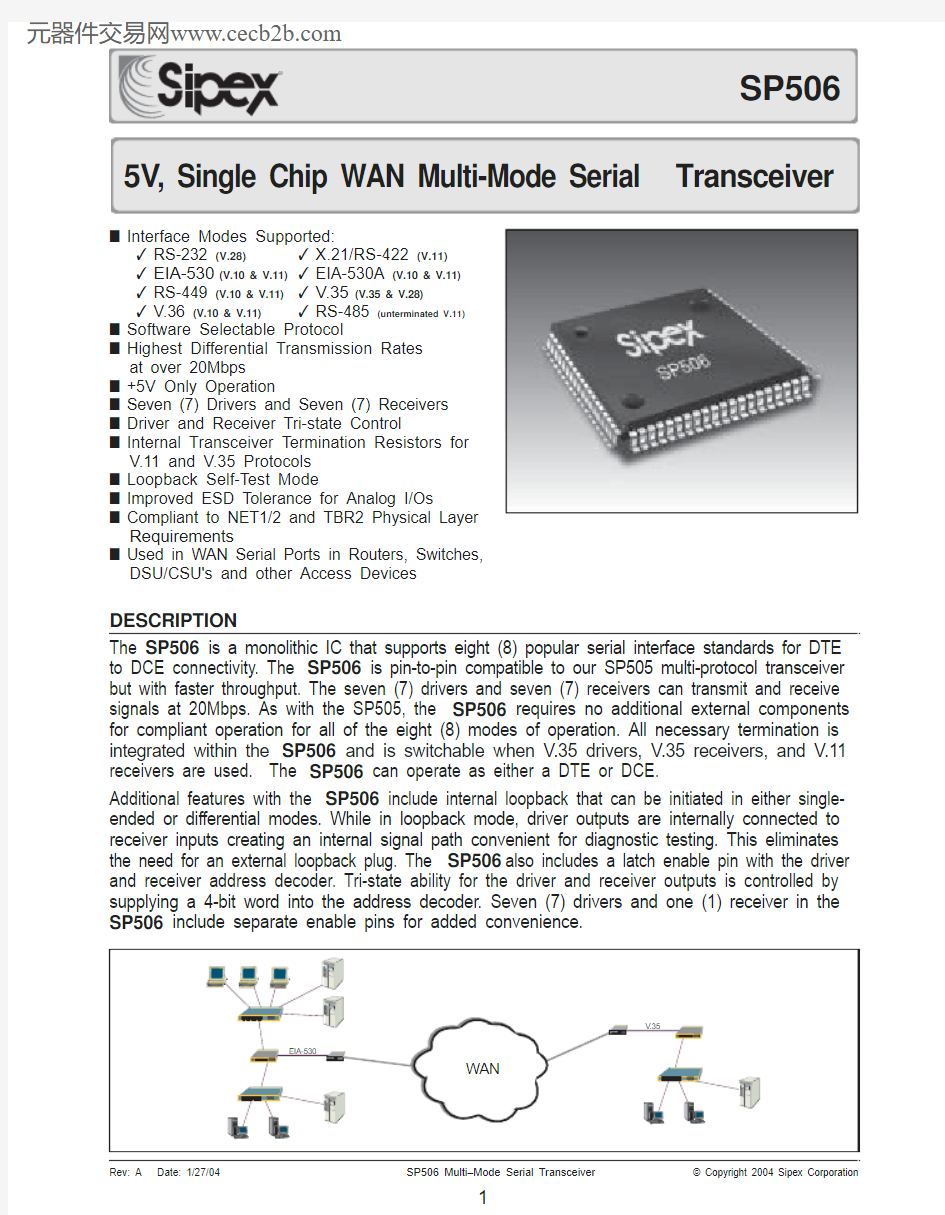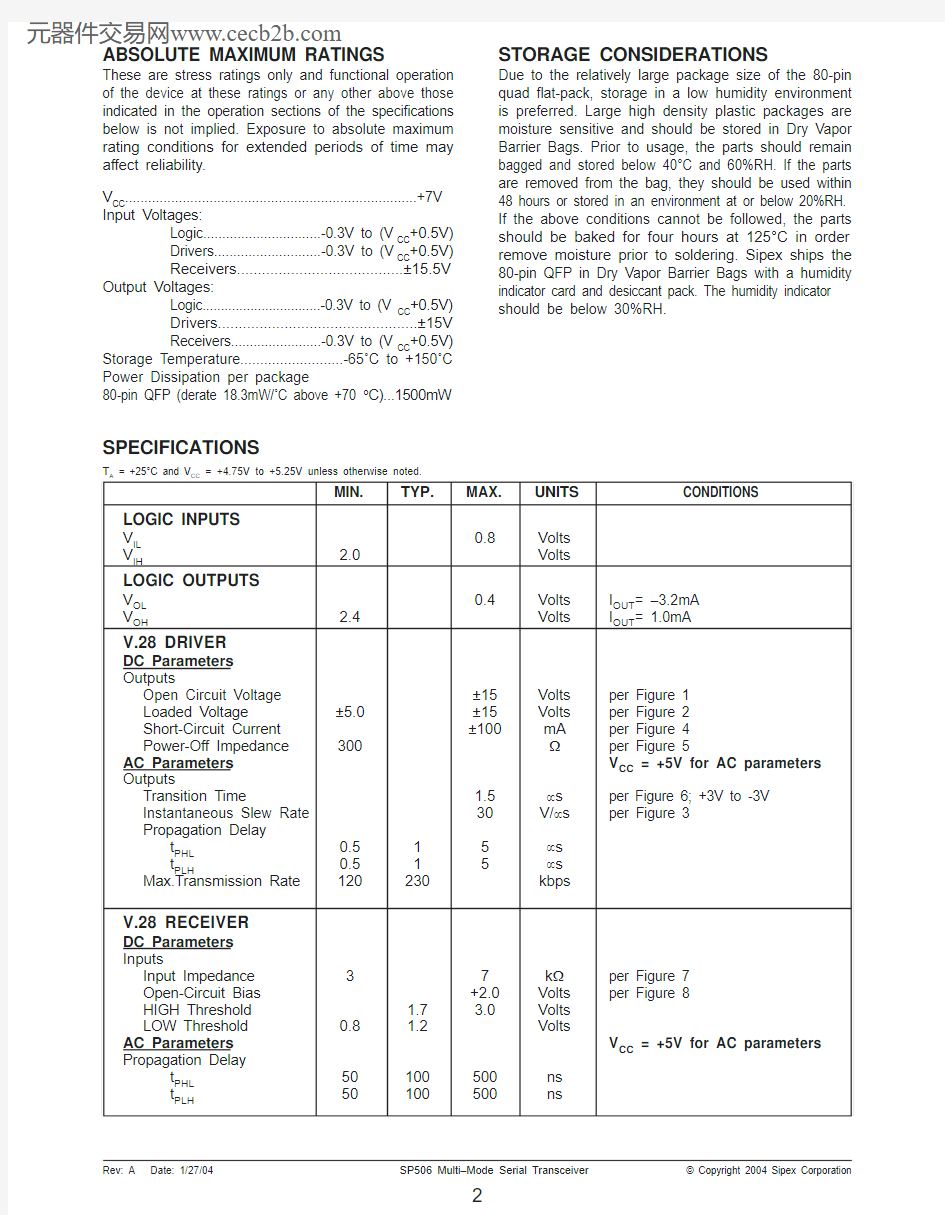SP506中文资料


The SP506 is a monolithic IC that supports eight (8) popular serial interface standards for DTE to DCE connectivity. The SP506 is pin-to-pin compatible to our SP505 multi-protocol transceiver but with faster throughput. The seven (7) drivers and seven (7) receivers can transmit and receive signals at 20Mbps. As with the SP505, the SP506 requires no additional external components for compliant operation for all of the eight (8) modes of operation. All necessary termination is integrated within the SP506 and is switchable when V.35 drivers, V.35 receivers, and V.11receivers are used. The SP506 can operate as either a DTE or DCE.
Additional features with the SP506 include internal loopback that can be initiated in either single-ended or differential modes. While in loopback mode, driver outputs are internally connected to receiver inputs creating an internal signal path convenient for diagnostic testing. This eliminates the need for an external loopback plug. The SP506 also includes a latch enable pin with the driver and receiver address decoder. Tri-state ability for the driver and receiver outputs is controlled by supplying a 4-bit word into the address decoder. Seven (7) drivers and one (1) receiver in the SP506 include separate enable pins for added convenience.
DESCRIPTION
■ Interface Modes Supported:
? RS-232 (V.28)
? X.21/RS-422 (V.11)? EIA-530 (V.10 & V.11)? EIA-530A (V.10 & V.11)? RS-449 (V.10 & V.11)? V.35 (V.35 & V.28)? V.36 (V.10 & V.11)? RS-485 (unterminated V.11)■ Software Selectable Protocol
■ Highest Differential Transmission Rates at over 20Mbps ■ +5V Only Operation
■ Seven (7) Drivers and Seven (7) Receivers ■ Driver and Receiver Tri-state Control
■ Internal Transceiver Termination Resistors for V.11 and V.35 Protocols ■ Loopback Self-Test Mode
■ Improved ESD Tolerance for Analog I/Os
■ Compliant to NET1/2 and TBR2 Physical Layer Requirements
■ Used in WAN Serial Ports in Routers, Switches,DSU/CSU's and other Access Devices
SPECIFICATIONS
T A = +25°C and V CC = +4.75V to +5.25V unless otherwise noted.
MIN.TYP.MAX.UNITS CONDITIONS
LOGIC INPUTS
V IL 0.8
Volts V IH
2.0
Volts LOGIC OUTPUTS
V OL 0.4
Volts I OUT = –3.2mA V OH
2.4
Volts
I OUT = 1.0mA
V.28 DRIVER
DC Parameters Outputs
Open Circuit Voltage ±15Volts per Figure 1Loaded Voltage
±5.0±15Volts per Figure 2Short-Circuit Current ±100
mA per Figure 4Power-Off Impedance 300
?per Figure 5
AC Parameters V CC = +5V for AC parameters Outputs
Transition Time
1.5μs per Figure 6; +3V to -3V Instantaneous Slew Rate 30
V/μs per Figure 3
Propagation Delay
t PHL 0.515μs t PLH
0.515
μs Max.Transmission Rate
120
230
kbps
V.28 RECEIVER
DC Parameters Inputs
Input Impedance 37k ?per Figure 7Open-Circuit Bias +2.0Volts per Figure 8
HIGH Threshold 1.7 3.0
Volts LOW Threshold 0.8 1.2Volts AC Parameters V CC = +5V for AC parameters
Propagation Delay
t PHL 50100500ns t PLH
50
100
500
ns
ABSOLUTE MAXIMUM RATINGS
These are stress ratings only and functional operation of the device at these ratings or any other above those indicated in the operation sections of the specifications below is not implied. Exposure to absolute maximum rating conditions for extended periods of time may affect reliability.
V CC ............................................................................+7V Input Voltages:
Logic...............................-0.3V to (V CC +0.5V)Drivers............................-0.3V to (V CC +0.5V)Receivers........................................±15.5V
Output Voltages:
Logic................................-0.3V to (V CC +0.5V)Drivers................................................±15V Receivers........................-0.3V to (V CC +0.5V)
Storage Temperature..........................-65?C to +150?C Power Dissipation per package
80-pin QFP (derate 18.3mW/?C above +70o C)...1500mW
STORAGE CONSIDERATIONS
Due to the relatively large package size of the 80-pin quad flat-pack, storage in a low humidity environment is preferred. Large high density plastic packages are moisture sensitive and should be stored in Dry Vapor Barrier Bags. Prior to usage, the parts should remain bagged and stored below 40°C and 60%RH. If the parts are removed from the bag, they should be used within 48 hours or stored in an environment at or below 20%RH.If the above conditions cannot be followed, the parts should be baked for four hours at 125°C in order remove moisture prior to soldering. Sipex ships the 80-pin QFP in Dry Vapor Barrier Bags with a humidity indicator card and desiccant pack. The humidity indicator should be below 30%RH.
元器件交易网https://www.360docs.net/doc/786089539.html,
元器件交易网https://www.360docs.net/doc/786089539.html,
OTHER AC CHARACTERISTICS
OTHER AC CHARACTERISTICS (Continued)
POWER REQUIREMENTS
PARAMETER MIN.TYP.MAX.UNITS CONDITIONS
V
CC
4.75
5.00 5.25Volts
I CC (No Mode Selected)30mA All I
CC
values are with V
CC
= +5V (V.28/RS-232)65mA f
IN
= 120kbps; Drivers active & loaded. (V.11/X.21)175mA f
IN
= 10Mbps; Drivers active & loaded. (EIA-530 & RS-449)250mA f
IN
= 10Mbps; Drivers active & loaded. (V.35)100mA V.35 @ f
IN
= 10Mbps, V.28 @ 20kbps;
Drivers active & loaded.
元器件交易网https://www.360docs.net/doc/786089539.html,
TEST CIRCUITS
Figure 6. V.28 Driver Output Rise/Fall Times Figure 5. V.28 Driver Output Power-Off Impedance
Figure 22. V.11 Receiver Input IV Graph
Figure 32. Driver Output Leakage Current Test Figure 33. Driver/Receiver Timing Test Circuit
Figure 38. Receiver Propagation Delays
Figure 39. Receiver Enable and Disable Times
Figure 40. V.28 (RS-232) and V.10 (RS-423) Driver Enable and Disable Times
Figure 41. Typical V.28 Driver Output Waveform Figure 42. Typical V.10 Driver Output Waveform
Figure 43. Typical V.11 Driver Output Waveforms Figure 44. Typical V.35 Driver Output Waveforms
PINOUT
PIN ASSIGNMENTS
CLOCK AND DATA GROUP
Pin 1 — RxD — Receive Data; TTL output, sourced from RD(a) and RD(b) inputs.
Pin 14 — TxD — TTL input ; transmit data source for SD(a) and SD(b) outputs.
Pin 15 — TxC — Transmit Clock; TTL input for TT driver outputs.
Pin 20 —RxC — Receive Clock; TTL output sourced from RT(a) and RT(b) inputs.
Pin 22 — ST — Send Timing; TTL input; source for ST(a) and ST(b) outputs.
Pin 37 — RT(a) — Receive Timing; analog input, inverted; source for RxC.
Pin 38 — RT(b) — Receive Timing; analog input, non-inverted; source for RxC.
Pin 42 — ST(a) — Send Timing; analog output, inverted; sourced from ST.
Pin 44 — ST(b) — Send Timing; analog output, non-inverted; sourced from ST.
Pin 59 — SD(b) — Analog Out — Send data, non-inverted; sourced from TxD.Pin 61 — SD(a) — Analog Out — Send data, inverted; sourced from TxD.
Pin 63 — TT(a) — Analog Out — Terminal Timing, inverted; sourced from TxC
Pin 65 — TT(b) — Analog Out — Terminal Timing, non–inverted; sourced from TxC. Pin 70 — RD(a) — Receive Data, analog input; inverted; source for RxD.
Pin 71 — RD(b) — Receive Data; analog input; non-inverted; source for RxD.
Pin 76 — SCT(a) — Serial Clock Transmit; analog input, inverted; source for SCT.
Pin 77 — SCT(b) — Serial Clock Transmit: analog input, non–inverted; source for SCT Pin 79 — SCT — Serial Clock Transmit; TTL output; sources from SCT(a) and SCT(b) inputs. CONTROL LINE GROUP
Pin 13 — DTR — Data Terminal Ready; TTL input; source for TR(a) and TR(b) outputs. Pin 16 — RTS — Ready To Send; TTL input; source for RS(a) and RS(b) outputs.
Pin 17 — RL — Remote Loopback; TTL input; source for RL(a) and RL(b) outputs.
Pin 19 — DCD— Data Carrier Detect; TTL output; sourced from RR(a) and RR(b) inputs. Pin 21 — RI — Ring In; TTL output; sourced from IC(a) and IC(b) inputs.
Pin 24 — LL — Local Loopback; TTL input; source for LL(a) and LL(b) outputs.
Pin 35 — RR(a)— Receiver Ready; analog input, inverted; source for DCD.
Pin 36 — RR(b)— Receiver Ready; analog input, non-inverted; source for DCD.
Pin 39 — IC(a)— Incoming Call; analog input, inverted; source for RI.
Pin 40 — IC(b)— Incoming Call; analog input,non-inverted; source for RI.
元器件交易网https://www.360docs.net/doc/786089539.html,
Pin 7 — SCTEN — Enables SCT receiver;active high; TTL input.
Pin 8 — LATCH — Latch control for decoder bits (pins 9-12), active low. Logic high input will make decoder transparent.
Pins 12–9 — DEC 0 – DEC 3 — Transmitter and receiver decode register; configures transmitter and receiver modes; TTL inputs.
Pin 18 — RLEN — Enables RL driver; active low; TTL input.
Pin 23 — STEN — Enables ST driver; active low; TTL input.
POWER SUPPLIES
Pins 25, 33, 41, 48, 55, 62, 73, 74 — V CC — +5V input.
Pins 29, 34, 43, 46, 50, 53, 57, 60, 64, 72, 75 —GND — Ground.
Pin 27 — V DD +10V Charge Pump Capacitor —Connects from V DD to V CC . Suggested capaci-tor size is 22μF, 16V.
Pin 32 — V SS –10V Charge Pump Capacitor —Connects from ground to V SS . Suggested ca-pacitor size is 22μF, 16V.
Pins 26 and 30 — C 1+ and C 1– — Charge Pump Capacitor — Connects from C 1+ to C 1–.Suggested capacitor size is 22μF, 16V.Pins 28 and 31 — C 2+ and C 2– — Charge Pump Capacitor — Connects from C 2+ to C 2–.Suggested capacitor size is 22μF, 16V.
Pin 45 — RL(b) — Remote Loopback; analog output, non-inverted; sourced from RL.Pin 47 — RL(a) — Remote Loopback; analog output inverted; sourced from RL.
Pin 49— LL(b) — Local Loopback; analog output, non-inverted; sourced from LL.Pin 51 — LL(a) — Local Loopback; analog output, inverted; sourced from LL.
Pin 52 — RS(b) — Ready To Send; analog output, non-inverted; sourced from RTS.Pin 54 —RS(a) — Ready To Send; analog output, inverted; sourced from RTS.
Pin 56 —TR(b) — Terminal Ready; analog output, non-inverted; sourced from DTR.Pin 58 — TR(a) — Terminal Ready; analog output, inverted; sourced from DTR.
Pin 66 —CS(a)— Clear To Send; analog input,inverted; source for CTS.
Pin 67 — CS(b)— Clear To Send; analog input,non-inverted; source for CTS.
Pin 68 —DM(a)— Data Mode; analog input,inverted; source for DSR.
Pin 69 — DM(b)— Data Mode; analog input,non-inverted; source for DSR
Pin 78 — DSR— Data Set Ready; TTL output;sourced from DM(a), DM(b) inputs.
Pin 80 —CTS— Clear To Send; TTL output;sourced from CS(a) and CS(b) inputs.
CONTROL REGISTERS
Pins 2 — SDEN — Enables TxD driver, active low; TTL input.
Pins 3 — TREN — Enables DTR driver, active low; TTL input.
Pins 4 — RSEN — Enables RTS driver, active low; TTL input.
Pins 5 — LLEN — Enables LL driver, active low; TTL input.
low; TTL input.
元器件交易网https://www.360docs.net/doc/786089539.html,
SP506 Driver Mode Selection
Table 1. SP506 Driver Decoder Table
SP506 Receiver Mode Selection
Table 2. SP506 Receiver Decoder Table
Figure 45. SP506 Typical Operating Circuit
80 PIN MQFP (MS-022 BC)
e
Seating Plane
0°–7.
c
C L
L
COMMON DIMENTIONS SYMBL MIN NOM
MAX c 0.1123.00L 0.73
0.88 1.03
L1
1.60 BASIC
PACKAGE: 80 PIN MQFP
元器件交易网https://www.360docs.net/doc/786089539.html,
